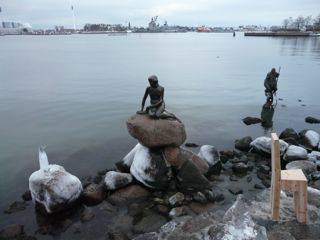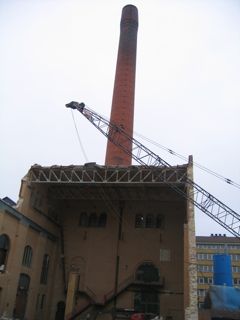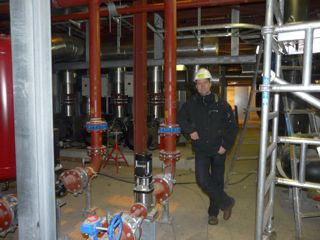Chilling Out in Copenhagen
Air Date: Week of August 20, 2010

The Little Mermaid presides over Copenhagen harbor, which will provide the cold water for the city's new district cooling plant.
Copenhagen will soon be using a very cool technology to ensure there's nothing rotting in Denmark. The first phase of its new district cooling system will soon be up, running and cooling the capital city. Living on Earth's Bruce Gellerman takes a tour and learns that not only will it dramatically cut CO2 emissions and energy...at times, it'll even be free.
Transcript
YOUNG: Here’s a cool idea from Copenhagen. As global warming heats up the planet, the city-owned utility plans to cool the Danish capital using an updated version of a century-old technology. The first phase of the new system just went on line. And not only will it enable Copenhagen to dramatically cut the use of air conditioning and reduce emissions of greenhouse gases. At times, it will cool-off the city for free.
Living on Earth Senior Correspondent Bruce Gellerman has our report.
GELLERMAN: Copenhagen’s first electric power plant still stands in the heart of the city. Built in 1892, it generated electricity until the 1970’s. And, ever since, it’s been mothballed waiting for someone to figure out what to do with the old brick building filled with pipes and outdated plumbing. That someone turns out to be engineer, Jan Hoge.

Copenhagen's first power plant.
HOGE: Here you can see we’re in an old power plant. This is the old chimney from the power plant.
GELLERMAN: Oh my gosh, it must be over 200 feet high?
HOGE: Something like that, yes.
GELLERMAN: Wow it’s huge.
HOGE: It’s huge, and old. [Laughs]
GELLERMAN: So they weren’t using this power plant for anything, or it was being used?

HOGE: It has been used. We have fired coal in here, and then after that it was oil for a period, and then due to environmental reasons – and it was also too small – then they stopped production here in the 70s, and since then it has been used for nothing you can say. So now we can say we use some of the old installations for a new purpose, so we think that’s a good idea.
GELLERMAN: Recycling.
HOGE: Exactly.
GELLERMAN: You’re recycling an entire power plant.
HOGE: [Laughs]
GELLERMAN: But instead of generating electricity, Copenhagen’s old power plant is being converted to produce district cooling, or as Jan Hoge says in Danish:
HOGE: Fjern koling…there you are. [Laughs]
GELLERMAN: Fjern koling?
HOGE: Fjern koling, perfect – you got it! [Laughs]
GELLERMAN: Actually, downtown Denver got it first in 1889, and district cooling – or centralized cooling as it’s sometimes called – is now used in Chicago, Las Vegas, Rockefeller Center in New York City, the U.S. Capital Building in Washington D.C., and it’s especially big in Europe.
HOGE: In our opinion if they can do it in Stockholm, which is a city further north than Copenhagen, and they can do it in Paris, which is further south of Copenhagen, why shouldn’t we do it in Copenhagen?

Jan Hoge leans on the pipes that return warm water back into the system. (Photo: Bruce Gellerman)
GELLERMAN: It took a lot of sweat and years of work, but Jan Hoge’s can-do spirit has paid off. Just as district heating has kept Copenhageners warm by capturing and distributing excess heat from generating plants, companies in the city center are now able to connect to a centralized source for cooling.
HOGE: By introducing district cooling we can produce cooling with heat. Sounds crazy but it’s an old technology. Yeah, It works.
GELLERMAN: Let’s go see it.
HOGE: Yes, let’s go do that.
[SOUNDS OF WALKING]
GELLERMAN: We put on hardhats and head inside the old power plant where workers are putting the finishing touches on the district cooling system.
HOGE: As you can see this is a construction site so we’ll have people working here. But the machine here on your left side is an absorption chiller – basically this is only a container; there’s not much technology inside this one.
GELLERMAN: This is really low tech! This is a plumbing job.
HOGE: This is low tech. It’s really simple. It just has to be tight, and a lot of iron. [Laughs]
GELLERMAN: The key to Copenhagen’s district cooling system and what makes it special is that it’s flexible. The plant will use two kinds of absorption chillers. Some are the old tried and true technology that chemically converts waste heat produced by the city’s coal and gas powered plants, and some chillers use electricity. Since Denmark gets a fifth of its electricity from wind power – the largest percentage of any country in the world – when it’s really blowing it can drive the cost of running the district cooling system way down.

Copenhagen’s windmills. (Photo: Jennifer Stevens-Curwood)
HOGE: This might sound a little bit strange but in Denmark we have periods where the electricity is not only zero, it will turn into a price of minus, which means you gain money using electricity – it sounds crazy. So I mean, this is interesting, yes?
GELLERMAN: But what’s really interesting and unique to district cooling Copenhagen-style can be found in the basement of the refurbished power plant.
HOGE: So now you are really in the heart of the cooling center. This is inlet for the seawater system. Inside here you have the pipe coming in and then you have these six pumps circulating the seawater into the cooling center and back into the harbor a little bit warmer.
GELLERMAN: Two pipes, each nearly a yard in diameter, buried 20 feet underground re-circulate water three quarters of a mile from Copenhagen’s harbor. Originally built to cool off the old power plants generators, today the system provides cold water to the new district cooling plant. In winter, fjern koling will be free cooling.
HOGE: If we didn’t have these pipes we didn’t have this project because it would be so expensive for us to put in new pipes in the ground. And although they’re more than a hundred years old they look fantastic. We just have to reline them and now we use the seawater from the harbor to cool down our chiller units, and through the so-called free cooling. And what is free cooling? You produce cold water purely from the water in the harbor.
GELLERMAN: In the winter the carbon footprint from Copenhagen’s district cooling system will be virtually zero. Over the year, CO2 emission will be nearly 70 percent less than traditional air conditioning units and energy costs will be cut 80 percent. And because it’s largely automated, Jan Hoge says the plant will require just one person working eight hours a week to change filters.

An employee puts the finishing touches on the district cooling system. (Photo: Bruce Gellerman)
HOGE: We think this is a good idea. And I also think this could be used other places. The thing is you have to find these resources. You have to find out where do you have resources that otherwise would have been wasted. So maybe in other cities this could be waste heat from the industry. There is a lot of waste heat from industry. Use it for cooling production.
GELLERMAN: This is just the first phase of Copenhagen’s new centralized system…delivering the big chill to the entire metropolitan area will take 15 years and cost a cool 400 million dollars. For Living on Earth. I’m Bruce Gellerman in Copenhagen, Denmark.
Living on Earth wants to hear from you!
Living on Earth
62 Calef Highway, Suite 212
Lee, NH 03861
Telephone: 617-287-4121
E-mail: comments@loe.org
Newsletter [Click here]
Donate to Living on Earth!
Living on Earth is an independent media program and relies entirely on contributions from listeners and institutions supporting public service. Please donate now to preserve an independent environmental voice.
NewsletterLiving on Earth offers a weekly delivery of the show's rundown to your mailbox. Sign up for our newsletter today!
 Sailors For The Sea: Be the change you want to sea.
Sailors For The Sea: Be the change you want to sea.
 The Grantham Foundation for the Protection of the Environment: Committed to protecting and improving the health of the global environment.
The Grantham Foundation for the Protection of the Environment: Committed to protecting and improving the health of the global environment.
 Contribute to Living on Earth and receive, as our gift to you, an archival print of one of Mark Seth Lender's extraordinary wildlife photographs. Follow the link to see Mark's current collection of photographs.
Contribute to Living on Earth and receive, as our gift to you, an archival print of one of Mark Seth Lender's extraordinary wildlife photographs. Follow the link to see Mark's current collection of photographs.
 Buy a signed copy of Mark Seth Lender's book Smeagull the Seagull & support Living on Earth
Buy a signed copy of Mark Seth Lender's book Smeagull the Seagull & support Living on Earth

